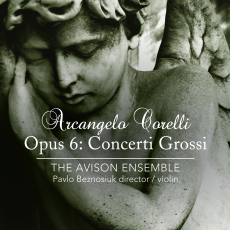The Avison Ensemble - Corelli: Opus 6 - International Record Review
Although Corelli worked on them over many years, continually tweaking and amending them right up to the moment when he sent them off to the Amsterdam-based publisher Etienne Roger, he never lived to see the publication of his 12 Concerti grossi, which eventually appeared in 1714, a year after his death, and on which his posthumous reputation largely rests. He seems to have been frustrated with what he regarded as Roger's procrastination in delaying their publication, but as soon as they appeared they rapidly became hugely popular, going through more than 10 editions in 20 years and becoming firmly established in the repertoire of groups across Europe. Nowhere was their popularity stronger than in England, where, as Simon Fleming suggests in his booklet note, the manner in which orchestras were formed for specific concerts, with little or no time available for rehearsal, made them ideal: ‘The concert organisers, or other billed performers, would take on the more challenging concertino roles, leaving the orchestral players the simpler ripieno parts.' As with anything which becomes so universally popular, Corelli's Op. 6 Concertos garnered their fair share of imitators, one of the most famous being Handel, who not only wrote is own set of 12 Concerti grossi in direct competition to Corelli's but also published them with the same opus number. The Avison Ensemble recorded the Handel set in 2010 (reviewed in September 2010), so it is certainly high time it tackled its progenitors.
From the first bars of the First Concerto in D, the Avison Ensemble sets its unique seal on the performance, with a delicately treading Largo quickly shifting gear effortlessly into an invigorating Allegro. Possibly the rapid alternation of the slow/fast material here is not helped by these extremes of tempo, which make for a sense of instability, but with the first appearance of the concertino group the music takes on a refreshingly vivid character, much enhanced by the outstanding Linn SACD sound. Pavlo Beznosiuk leads the concertino group very much from the front, occasionally entering into a lively partnership with Caroline Balding - there is a wonderful passage of overlapping violins in the first movement of the Fourth Concerto - and inspiring his team to some tremendous feats of virtuosity. Not to be outdone, the ripieno delivers its voice with impeccable precision, creating, especially in the quicker movements, playing of almost breathtaking clarity. This may on the face of it be relatively simple music, but to deliver it at such high speed with such flawless ensemble is a noble achievement.
It is certainly in the quicker movements that the Avison Ensemble shows its true mettle, and looking down at the list of highlights had noted for mention, I see that they all come from the fast movements; in short, if it's fast, it's impressive. Among these is the disarmingly intimate organ solo from Roger Hamilton at the end of the slow movement of the Second Concerto. He is playing on a delightful box organ, which also peeps its pipes over the parapet in the Third, Eighth and Eleventh Concertos.
Considering it is not just the most famous of the 12 Concerti Grossi but also the one over which Fleming dwells the most extensively in his booklet notes, it would be amiss of me not to make some mention of the so-called Christmas Concerto, No 8 in G minor. Whether or not it dates back to Christmas Eve 1690, as Fleming suggests, it is only the final ‘Pastoral' which has a clear Christmas connection, taking the form of a gently lilting Siciliano with hints of the rustic instruments traditionally associated with shepherds, bagpipes and pipes. The Avison Ensemble gives this movement an utterly enchanting delicacy, more, perhaps, in the manner of an elegant court dance than shepherds celebrating a birth in the fields, but infinitely sweet and charming and a fitting climax in a very impressive pair of discs.

